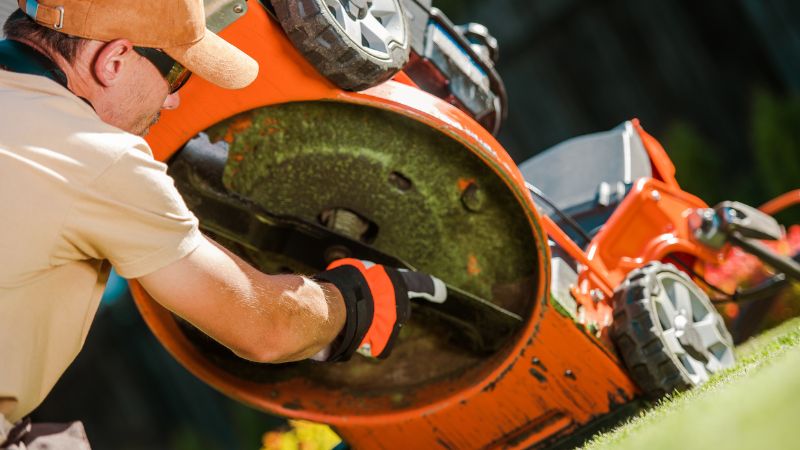How to Balance a Lawn Mower Blade
There is more to a perfect lawn than the eye can see. Behind the scenes is the unsung hero of the perfect lawn, and that is the humble lawnmower. Digging a little further, we find the one piece of the mower that does all the work: the unassuming blade.
Still, it takes more than a blade to produce the perfect lawn. There is a crucial but often overlooked aspect: balance.
This guide looks at the fine art of balancing mower blades. Something that is seldom thought about but can make a huge difference to the health of your lawn and the efficiency.
So join us as we look at the art of balancing your lawnmower blade and getting that perfect cut.
The basics of lawn mower blade balancing
Before we begin, we need to understand why it is important to keep the blade balanced.
The purpose of a balanced blade
A well-balanced blade is the final piece of the puzzle that makes everything else work in harmony. The main purpose of balancing is to ensure that the weight distribution along the blade is uniform. This will minimize vibrations and produce a smooth mowing experience.
How imbalance affects the performance of the mower
Have you ever tried to push a shopping cart with a locked or out-of-balance wheel on the front? That annoying way that is heading in the wrong direction and doesn’t do what you want. Now, imagine if a machine drove the cart. You might not even notice the out-of-balance wheel and end up with much larger problems.
Even a tiny imbalance in a blade can lead to uneven cuts in your lawn and eventually damage to the engine and chassis of the mower.

Components involved in blade balancing
A few tools can be used to balance a blade, and these range from spinning the blade (with the spark plug disconnected, of course) and checking that it is not wabbling or uneven. I sometimes mark the line of the blade’s end on the mower body’s inside with a marker. If the other side of the blade does not hit the same line, your blade is out of balance.
The other DIY method is to balance the blade on a screwdriver or nail using the hole in the middle of the blade. If it balances then all is good. If not, your blade needs work.
A blade balancing tool is not expensive and is easy to use. You simply place the blade on the Precision Blade Balancer, and you can instantly tell if the blade is balanced. A more expensive Magnetic Wall Mount Blade Balancer could be good if you want to use a grinder and need guidance. I have not used this a magnetic blade balancer, so I cannot comment on how well it works. It appears to be well-built.
Signs of an unbalanced lawn mower blade
If you have an unbalanced blade, you should be able to tell by just using the machine. These are a few of the tell-tail signs that let me know that the blade may need some attention.
Lawnmowing101 Membership

Build a six-figure lawn care business
Lawn Care Software

Get Your Lawn Care Business Running Smoothly
Easier for you and your customers. Jobber helps you quote, schedule, invoice, and get paid—all in one place.
Vibrations and shaking during use
This is the most common symptom; You can usually tell if the blade is out of balance because of the excessive vibrations coming from the machine. If you feel any unusual or excessive vibrations, stop the machine, disconnect the spark plug connecter, and check the blade.
Uneven cut or mowing patterns
This is another common symptom. Sometimes, I can tell a blade is unbalanced just by looking at the lawn, but I have seen people keep working with no idea they have an issue. However, an unbalanced blade is not always a given in this situation, as a collapsed barring or worn axle bush could give the same symptom. Give the wheels a shake one by one; if there is any play, this could rule out the blade.

Damage to the mower deck or blade
If you have hit something with the edge of the blade then you may have bent it. This will give you both the symptoms above and possibly damage the deck as well. It is not always that easy to tell. Sometimes, you may think it’s ok, but it’s not.
When I had workers, I used to service their mowers once a month. Sometimes, one of them had a bent blade, and they didn’t even know. This is more likely to be a small bend that will not be immediately obvious but will start to show symptoms over time.
It Might be the crankshaft.
This is the worst-case scenario because if the crankshaft is bent, it could be the end of your mower. Usually, mowers have an aluminum blade holder with a couple of keys that hold the blade. The keys are usually small cinders of aluminum, and their job is to break if the blade hits anything.
Because the key breaks, the crankshaft does not take the blow. This means instead of possibly doing irreversible damage to your mower; you break a $20 part. Sounds fair to me.
I will talk about how to check your crankshaft in the next section.
Step-by-step guide for balancing your blades.
Safety precautions before starting the process
If you are going to use a grinder you will need earmuffs and safety glasses. I can’t recommend the safety glasses highly enough. After going to the emergency clinic and having dried metal fragments scraped off my eyeball with a scalpel(a horrific experience.) I would not recommend ever using a grinder without safety glasses, even if it’s just for a minute.

Step 1: Removing the blade from the mower
Remove the cap from the spark plug before you begin. Now remove the blade. This can be done the old-fashioned way with a socket wrench and a 2×4 piece of wood stopping the blade from moving. This will work fine as long as the blade bolt has not been over-enthusiastically tightened at the local lawn mowing shop with an impact wrench hooked up to a compressor.
If your blade has been tightened within an inch of its life (which shouldn’t happen), then you may need a battery power impact wrench to undo it. You will need a wrench that has more than one speed. I normally run through the speeds until I find one that unbolts the blade.
Inspecting the blade for damage or wear
I’m a bit lazy here. I have a new blade in my workshop, and I simply place one blade on top of the other to ensure it is not bent. If it is bent I throw it away and replace it with a new blade. Blades are made out of cast steel; they CANNOT be bent back, so don’t bother trying. Once the structural integrity of the blade has been compromised, it is a write-off.
Assuming the said blade is not bent, we will now proceed to sharpen your blade.
Listen to audiobooks while you work.

With a sixty-day free trial
Discover millions of ebooks, audiobooks, and so much more for just $9.99/month.
Finding the heavy spot on the blade
Finding the heavier spot on a blade is not as hard as it sounds. All you need to do is balance the blade horizontally using something like a screwdriver inserted through the center hole. Allow the blade to settle and it should sit level. If one side tilts downward it is the heavier side of the blade and needs correction.

Step 2: The sharpening process using a blade balancer
Set the blade on the balancer (or screwdriver), observe the heavy side, and mark it with a Sharpie. Now, take the blade and place it in a sharpener or a vice.
Use a grinder and run it along the cutting edge on both ends of the blade at a 30 to 40-degree angle. I normally count the strokes as I grind and will typically do a third more on the heavy side.
Now replace the blade on the balancer. Is it level? If not, take a small amount off the heavy site. Do not take off too much. You can’t add it back on.
Rinse and repeat until the blade properly sits on the balancer without any tilt.
Step 3: Reinstalling the balanced blade on the mower
Now that your blade is sharp and balanced, it is time to return it to the machine. Remember what a pig it was to remove the blade at the beginning? Do you want to do that again next time? Of course not!
This is where Copper Anti-Seize Lubricant comes in. This fantastic lubricant is made out of clay and copper (amongst other things), which you can use on your blade holder. It will hold tight but be easy to remove next time. My life has got a lot easier since I found this stuff.
When you fix the blade back on, don’t overtighten it. I like to use a setting of two or three on the impact wrench. You want it tight but not overtight (like the mower shop did) that time.
I then fire up the mower and let it run for a few minutes to ensure everything is okay.
Conclusion: How to Balance a Lawn Mower Blade
Now that you know how important balance is, you cannot be aware and listen for any tell-tale signs of trouble while you mow your lawn.
You will now know how to deal with the situation if you hear any sounds or see any symptoms. In your garage, you should now have the tools to replace or re-balance your blade.
You now know the proper way to sharpen a blade so it cuts evenly and efficiently. Not only do you get a great-looking yard, but you will now get a longer life out of your lawn mower.
Frequently asked questions.
Do lawn mower blades need to be timed?
Do new lawn mower blades need sharpening?
Can you sharpen lawn mower blades without removing them?
How often should you change your lawn mower blades?
Get tips & tricks on how to grow a profitable lawn care business delivered to you inbox every week.






Leave a Reply